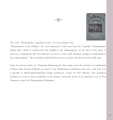Pali teachings : ค้นหาหนังสือธรรมะ หน้า 4 / 4
หน้าหนังสือทั้งหมด

187
The Sacred Formulas of Luang Phaw Wat Paknam
For example, if there were statements about constructing a
Dhamma Hall or a monk's shelter soon, then this must happen.
In short, the temple must produce results as soon as it can.
Thus, the first sac
The teachings of Luang Phaw Wat Paknam emphasize three sacred formulas essential for temple prosperity: cleanliness, diligent teaching of Dhamma, and frequent meditation practice. Cleanliness is vital

6
The Teachings of Luang Phaw Dhammajayo
immersing himself in the study and practice of the
Buddha's pure teachings. For almost 40 years, he
has always emphasized to the thousands of those
who follow his teachings at the Dhammakaya
Temple, b
Luang Phaw Dhammajayo has dedicated nearly 40 years to promoting the Buddha's teachings, asserting that true world peace originates from inner peace. He emphasizes everyone's role in enhancing humanit

15
Tomorrow The World Will Change
Tomorrow The World Will Change
Religions for Peace
Our global community is comprised of people seeking refuge in various faiths. For the most part, the founder of each religion – be it Buddhism, Chr
Our global community is made up of individuals seeking refuge in different faiths, all promoting love for fellow humans. To adhere to these teachings, we must avoid exploitation and violence. History

29
The Timeless Teachings of the Buddha
after I leave this world, my Teaching (the Dhamma) will be your teacher in my place.”
The Buddha blessed us with his Teachings and his sense of Discipline to carry us forward in his place. The gifts
After leaving this world, the Buddha offered the teachings of the Dhamma as a guide for his followers. His teachings have withstood the test of time, showcasing their timeless relevance. The commitmen

32
Nagasena's Enlightenment and Teachings
After listening to Rohana, Nagasena was impressed with what Rohana had to say and thus he desired to learn more about the Buddha's teachings. Nagasena then asked for permission from his parents to be
Nagasena, inspired by Rohana, sought to learn the Buddha's teachings and was ordained as a novice. Through pure living and dedicated practice, he attained enlightenment and became proficient in Buddhi

47
The Value of Dhamma Learning and Almsgiving
and study the Dhamma to the best of their ability. By passing on
the knowledge monks learn from the teachings of Lord Buddha,
monks are in return offering a gift that is more valuable than
anyth
This text discusses the reciprocal relationship between monks and the community through the exchange of alms and teachings. The author emphasizes the importance of monks learning the Dhamma to offer v

56
Ceremony of the Buddha's Relics
Near the Buddha's image, the venerable monks will recite. They will chant the sacred verses of the Buddha's teachings. When the Buddha's relics are displayed, the monks will perform the customary rite
The ceremony of the Buddha's relics involves venerable monks reciting sacred verses and performing customary rites. During this event, which is part of a sacred assembly, the relics are displayed to d

29
Introduction to Dhammakaya Meditation
The word “Dhammakaya” appealed to him. The Great Master said, “Dhammakaya is the Buddha.” He even referenced a Pali term from the Tripitika: “Dhammakayo (aham iti.pi,” (Pali) to confirm that the Buddh
The text discusses the meaning of Dhammakaya as the essence of Buddha, citing references from Pali texts. It mentions the influence of Khun Mae Acariya Chandra in advancing meditation practices and ho

27
Exploring the Manuscripts of Nong Pa Fa Cave
The manuscripts of the Nong Pa Fa Cave have two forms of writing: Dham Lao from Laos, and Dham Lanna from northern Thailand. These two scripts are very similar, especially on manuscripts dating back s
The manuscripts of the Nong Pa Fa Cave showcase two primary forms of writing: Dham Lao from Laos and Dham Lanna from northern Thailand. While these scripts exhibit notable similarities, especially in

61
The Pali Language and the Theravadin Tradition
NORMAN, K.R.
1983 “The Pali Language and the Theravadin Tradition.”
A History of Indian Literature: 1-2, edited by Jan Gonda. Wiesbaden: Otto Harrassowitz.
PEW Research Center.
2017 “World Bu
This text discusses the significance of the Pali language within the Theravadin Buddhist tradition. It examines its historical roots, literary contributions, and the ongoing impact on Buddhist practic

79
Understanding Dhammakāya: A Noble Identity
As a noun, the term refers to the new identity of a noble person once he/she is transubstantiated either from the worldly plane to a supramundane plane or from a lower transcendent state to a higher.
The term Dhammakāya refers to the new identity of a noble person following transubstantiation, highlighting different levels of realization. It embodies the reality spiritually identified with the Bud

78
The Teachings of the Buddha
The Teachings of the Buddha
The Teachings of the Buddha are known as Dhamma, a Pali word for the Truth, the law of righteousness. In his first sermon the Buddha emphasized that one should live the Mi
The Teachings of the Buddha, known as Dhamma, emphasize the Middle Way, avoiding extremes of indulgence and self-mortification. Central to Buddha's teachings are the Four Noble Truths, which acknowled

72
Understanding the Levels of Dhammakāya and Noble Disciples
In regard to the different levels of dhammakāya, the canon talks about the different states of trainees (sekha) and non-trainees (asekha). The former refers to states in which a further course is yet
The text elaborates on the different levels of dhammakāya, categorizing trainees and non-trainees based on their qualities and practices. Trainees are seen as individuals who still have further course

71
Understanding Dhamma and Monastic Disciplines
8. Dhamma and Monastic Disciplines
Dhamma has two meanings.
First: it means that things are right and good, such as kindness and respect, tolerance and patience, avoidance of whining and impatience.
Dhamma has a dual meaning: it encompasses moral aspects like kindness and respect, as well as truths about life including birth, ageing, sickness, and death. This concept is grounded in the teachings

181
Understanding Internal and External Fools in Buddhism
1) External Fools include non-Buddhists. They are
determined to demolish Buddhism, whether they are of other
religious affiliations or not. They typically try to cast aspersions
upon Buddhist monks. W
The text discusses two types of fools in Buddhism: External Fools, who are non-Buddhists aiming to undermine the faith by misrepresenting its teachings, and Internal Fools, who are Buddhists lacking r

10
Overcoming Kilesa: A Buddhist Perspective
learn how to improve and "win" the internal battle against
our own kilesa. Although people generally recognize the fact
that they acquire bad habits throughout their lives, they may
not recognize that
This book explores the concept of kilesa, or our negative tendencies and habits, through a Buddhist lens. It emphasizes the importance of acknowledging our imperfections and understanding that the acc

121
Truth for the Family: Lessons from the Buddha
Part Five: Truth for the Family
2. Ideally, he/she should be extremely intelligent,
exceptionally virtuous, exceedingly knowledgeable
of the truths about life (be enlightened), and all
his knowledge m
In this passage, we delve into the qualities of an ideal mentor and the essence of the Buddha's teachings. The ideal mentor is someone who is not only intelligent and virtuous but also knowledgeable f

2
Message from The Most Ven. Phrarajabhavanavisudh - World Peace Ethics Contest 2007
Message from The Most Ven. Phrarajabhavanavisudh
On occasion of the Examination Day for the World Peace Ethics Contest 2007
Greetings to all contestants of the World Peace Ethics Contest 2007,
The
In a heartfelt message for the World Peace Ethics Contest 2007, The Most Ven. Phrarajabhavanavisudh encourages contestants to embrace the universal truths of the Buddha's teachings. He highlights the

181
Understanding External and Internal Fools in Buddhism
1) External Fools include non-Buddhists. They are determined to demolish Buddhism, whether they are of other religious affiliations or not. They typically try to cast aspersions upon Buddhist monks. W
In Buddhism, External Fools are non-Buddhists who seek to distort and undermine Buddhist teachings, casting aspersions on monks and creating confusion. Internal Fools, on the other hand, are Buddhists

71
Growth of Dhammakaya Foundation's Global Influence
ROM QUALITY GREW QUANTITY
The reputation for training offered by the Dhammakaya Foundation has spread primarily by word of mouth, increasing the popularity of activities held, as the years pass by. P
The Dhammakaya Foundation's dedication to meditation training has led to a significant reputation, expanding through word of mouth and enhancing lives. Local branches in Thailand and abroad facilitate
